Our verdict
- Top pick in best walking shoes for wide feet
- Top pick in best walking shoes with a wide toebox
Pros
- Rocker sole propels you forward
- Copious amount of cushioning
- Amazingly comfortable step-in feel
- Highly durable and abrasion-resistant
- More stable than it seems!
- Can go from road to trail
- Accommodating toebox
Cons
- Needs some getting used to
- Heavier than average
- Slippery when wet
Audience verdict
Comparison
The most similar walking shoes compared
+ + Add a shoe | |||||
|---|---|---|---|---|---|
| Audience score | 83 Good! | 92 Superb! | 82 Decent! | 91 Great! | |
| Price | $160 | $160 | $140 | $110 | |
| Arch support | Neutral | Neutral | Neutral | Neutral | |
| Shock absorption | High | Moderate | Moderate | High | |
| Energy return | Low | Moderate | Moderate | High | |
| Traction | Moderate | Moderate | - | Moderate | |
| Condition | Bunions | - | - | - | |
| Orthotic friendly | ✓ | ✓ | ✓ | ✓ | |
| Weight lab Weight brand | 13.4 oz / 381g 13 oz / 369g | 11.3 oz / 320g 11.1 oz / 315g | 10.9 oz / 309g 10.9 oz / 309g | 10.8 oz / 306g 10.8 oz / 305g | |
| Breathability | Moderate | Breathable | Warm | Moderate | |
| Use | CityDisneyEuropeRecovery | For standing all dayCityDisneyEuropeFor nurses | For standing all dayCityDisneyEurope | CityDisneyEurope | |
| Size | Slightly small | True to size | True to size | True to size | |
| Midsole softness | Balanced | Balanced | Balanced | Soft | |
| Difference in midsole softness in cold | Small | Normal | Big | Small | |
| Insole thickness | Average | Average | Average | Thin | |
| Removable insole | ✓ | ✓ | ✓ | ✓ | |
| Stiffness | Stiff | Moderate | Stiff | Moderate | |
| Torsional rigidity | Stiff | Moderate | Stiff | Stiff | |
| Heel counter stiffness | Stiff | Flexible | Moderate | Flexible | |
| Heel tab | Finger loop | None | Finger loop | None | |
| Drop lab | 21.4 mm | 12.4 mm | 8.0 mm | 9.3 mm | |
| Heel stack lab | 45.7 mm | 33.1 mm | 34.1 mm | 34.9 mm | |
| Forefoot | 24.3 mm | 20.7 mm | 26.1 mm | 25.6 mm | |
| Width / fit | Wide | Medium | Narrow | Narrow | |
| Toebox width | Wide | Medium | Narrow | Medium | |
| Closure | Laces | Laces | Bungee laces | Laces | |
| Toebox durability | Decent | Decent | Good | Good | |
| Heel padding durability | Decent | Decent | - | Decent | |
| Outsole durability | Good | Decent | - | Decent | |
| Midsole width - forefoot | Average | Wide | Average | Average | |
| Midsole width - heel | Wide | Wide | Average | Wide | |
| Outsole hardness | Average | Average | Average | Very hard | |
| Outsole thickness | Thick | Average | Average | Average | |
| Tongue padding | Thick | Average | Average | Thick | |
| Tongue: gusset type | Both sides (semi) | None | None | Bootie | |
| Material | Mesh | Mesh | - | Mesh | |
| Ranking | #33 Bottom 8% | #4 Top 12% | #34 Bottom 5% | #6 Top 17% | |
| Popularity | #25 Bottom 30% | #3 Top 9% | #6 Top 17% | #7 Top 20% |
Who should buy
In our opinion, you won't be able to get enough of the KEEN WK400 if you want:
- a rocker-bottom walking shoe that pushes you to clock up those steps
- a mind-blowing amount of underfoot cushioning and support
- a durable pair with a hard-wearing outsole that can go from concrete to trail

Who should NOT buy
If you find the shoe's design too exotic but want to experience the benefits of a max-cushioned, rockered shoe, we recommend the Nike Motiva as an alternative.
Another highly cushioned, stable, and supportive alternative for all-day wear is the Hoka Clifton LS. This one has a non-rockered traditional sole shape.
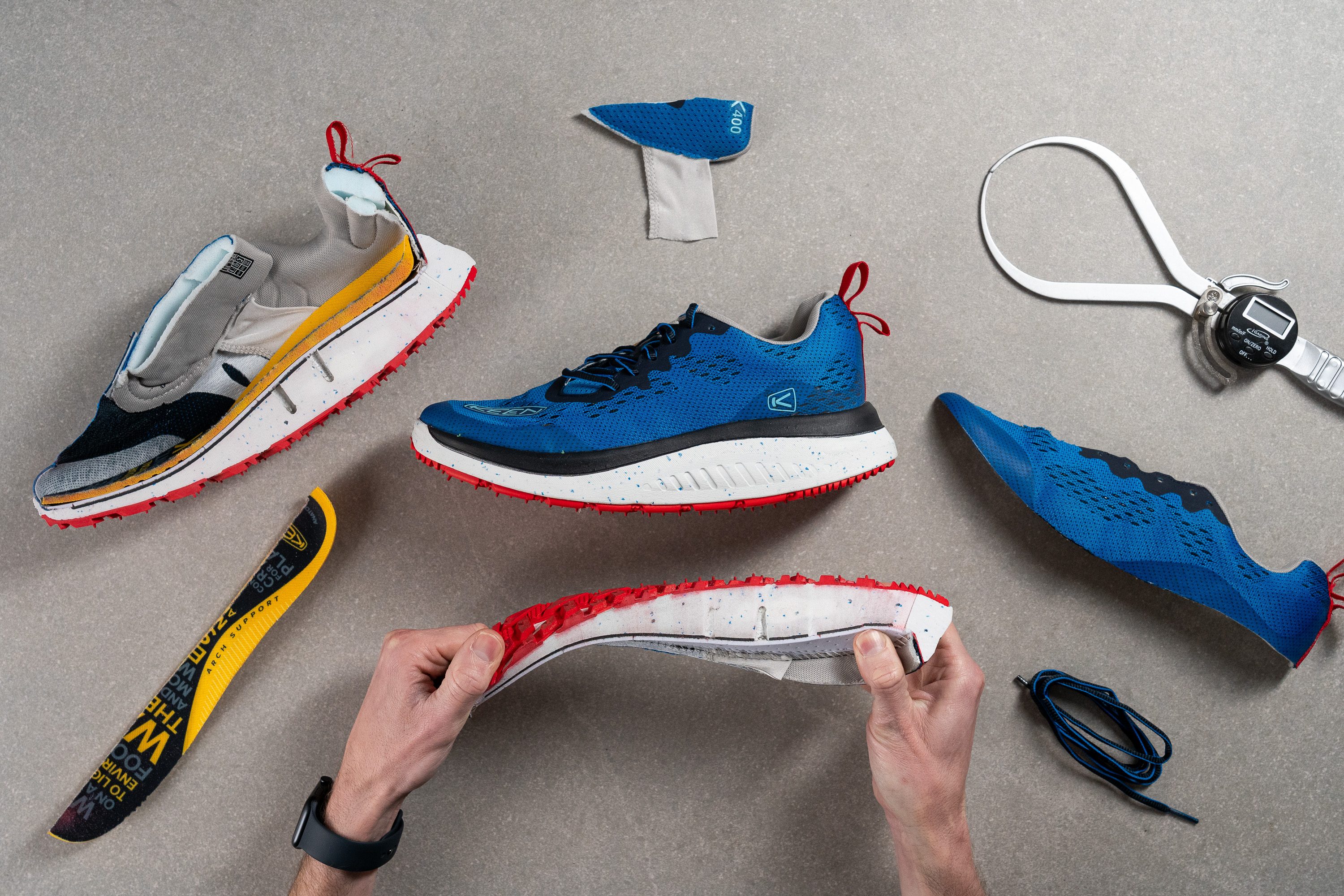
Cushioning
Shock absorption
The amount of cushioning and impact protection offered by this KEEN shoe is incredible. We could walk all day long in it without a hint of discomfort or foot fatigue! No wonder it returned some of the highest shock absorption readings in our lab (131 SA)!
Because of that, we can even recommend the WK400 as a recovery shoe for someone whose feet and legs get beaten up by sports and training.

| WK400 | 131 SA |
| Average | 111 SA |
Energy return
The WK400 showed a very low energy return of 40.4% which reflected the low-rebound nature of its platform. But even though the shoe didn't feel particularly bouncy, we never felt like it lacked a dynamic ride.
Its ultra-aggressive rocker made sure that the transitions felt smooth and effortless.
| WK400 | 40.4% |
| Average | 51.1% |
Heel stack
Just when we think that footwear cushioning can't get any thicker, we get an even higher-stacked shoe in our lab.

The WK400 beats our previous heel stack record of 40.0 mm with a scandalous 45.7 mm measurement!
| WK400 | 45.7 mm |
| Average | 32.3 mm |
Forefoot stack
But don't worry, the shoe's forefoot feels much more down to earth.
With a caliper measurement of 24.3 mm, it is only a couple of millimeters thicker than average. It helped us get in touch with the surface beneath our feet, making the ride stable even when the terrain was bumpy and hilly.
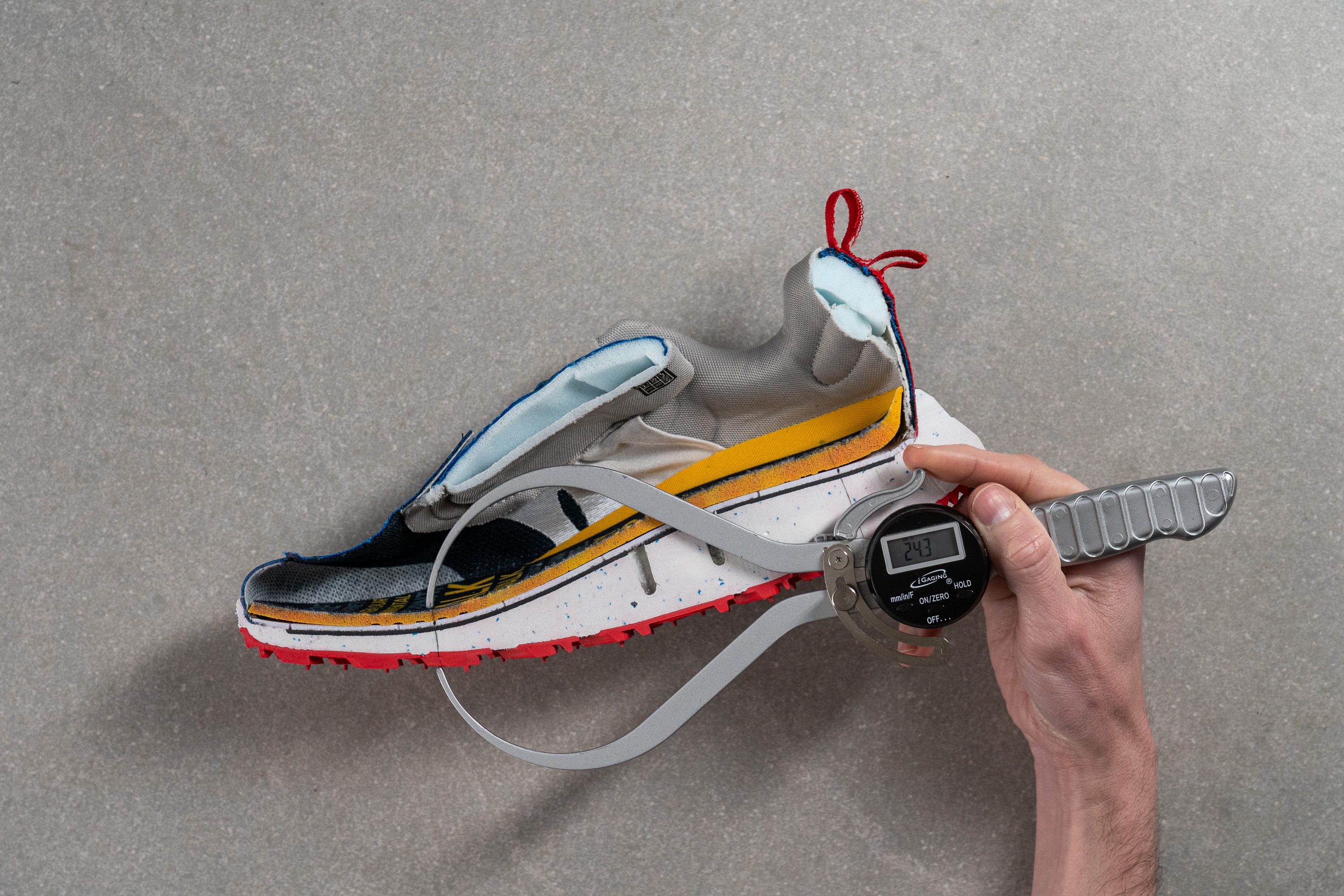
| WK400 | 24.3 mm |
| Average | 21.9 mm |
Drop
The KEEN WK400 has a humongous drop of 21.4 mm. This number is never-before-seen in our lab but so is the shoe's midsole shape.
What's the benefit of this setup? Significantly less pressure on your feet and Achilles.
When the heel is elevated above the toes, it activates a different biomechanics compared to low-drop, or flat shoes. Your own foot muscles are less activated but in return, high drop shoes give you plenty of all-day comfort and support.
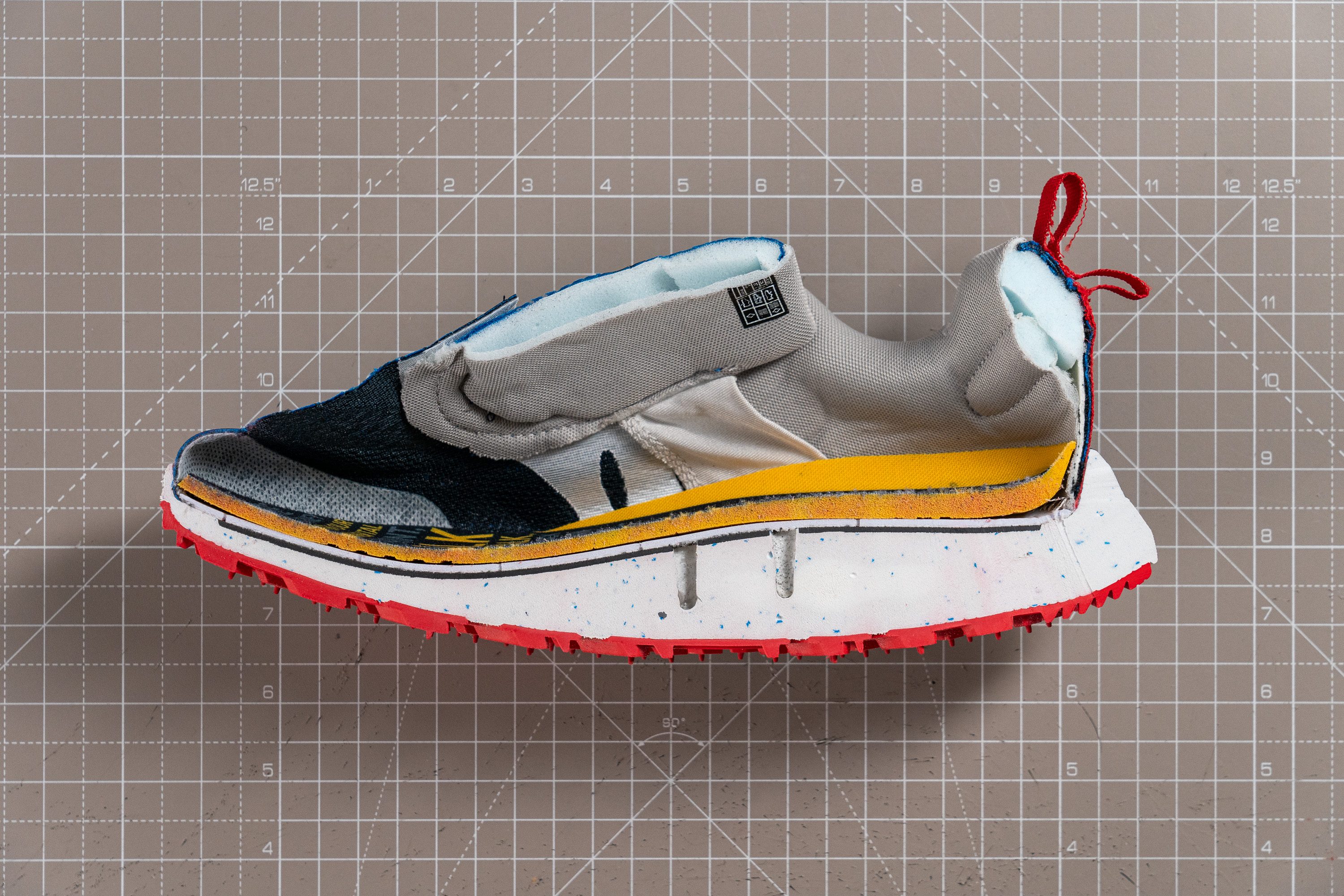
| WK400 | 21.4 mm |
| Average | 10.4 mm |
Midsole softness
The WK400 also treated our feet to a comfortably soft cushioning. We could feel a sweet compression even through the stiff nylon plate.
To measure the shoe's foam softness, we pressed a durometer against its half-cut midsole. It returned a reading of 22.0 HA which is indeed on the soft side of walking shoes (15% softer than average).
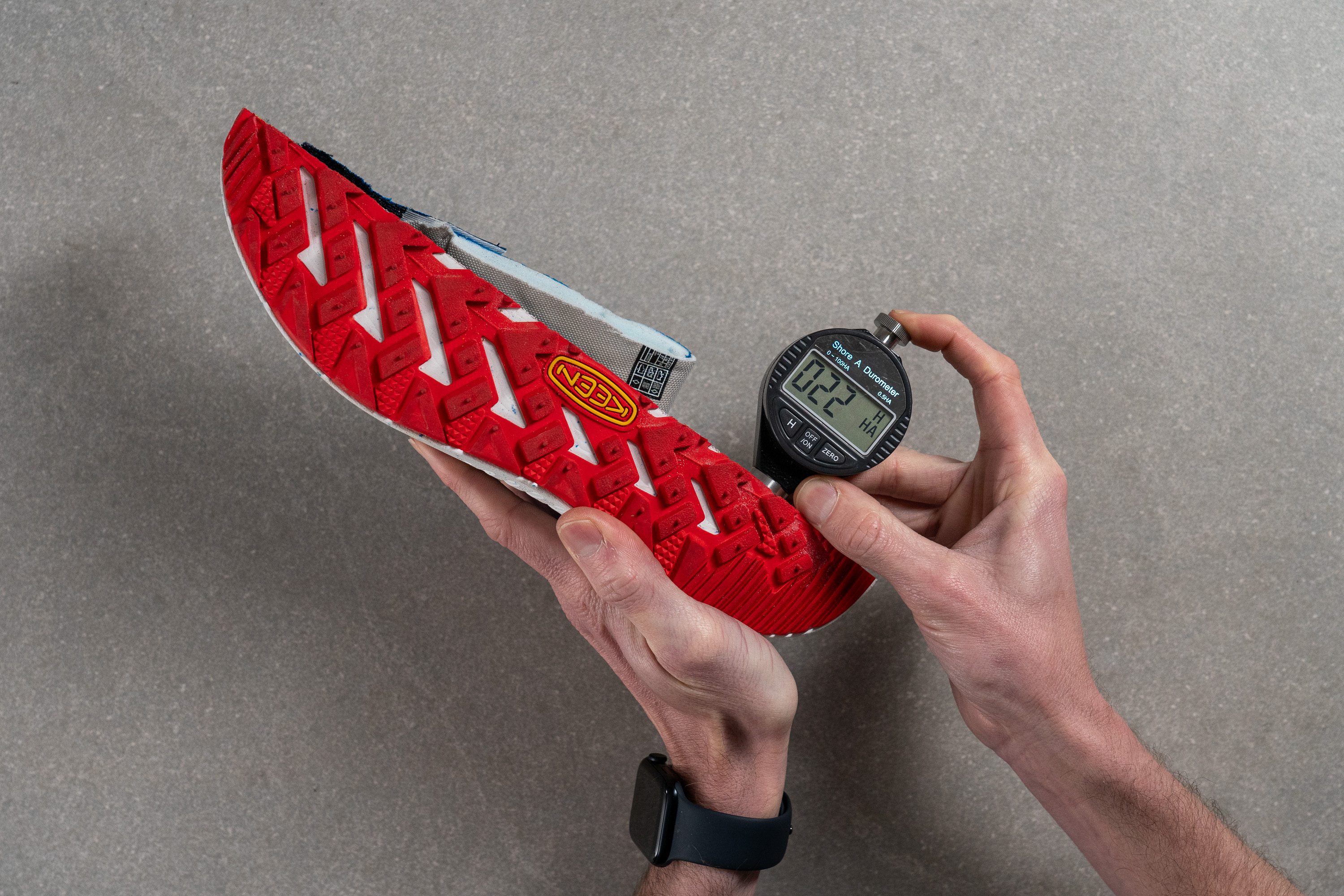
| WK400 | 22.0 HA |
| Average | 26.4 HA |
Rocker
But the most striking feature of the KEEN WK400 is, of course, its rocker-bottom sole. Called the KEEN.CURVE, this rounded shape works as an actual rocking chair for your feet!
Even though it felt a little wonky at first, it took us minutes to get comfortable with the shoe's odd shape. But once we were there, we couldn't stop going!
This KEEN shoe brilliantly accommodated the biomechanics of walking, helping our feet roll smoothly and effortlessly through the gait cycle. It encouraged us to walk longer distances!
But be prepared that standing in the KEEN WK400 feels rather funky. You cannot really stand still in the shoe and slight rocking is the only option.
Like we said, the shoe wants you to keep going.
Size and fit
Size
KEEN WK400 fits slightly small (27 votes).
Internal length
| WK400 | 273.6 mm |
| Average | 269.6 mm |
Width / Fit
What the brand calls a "Contoured Fit" turns out to be a generously accommodating fit! Definitely not the kind of one-to-one fit that walkers with slimmer feet may be looking for. But a pleasant surprise for wide-footers.
Having retrieved a gel mold of the shoe's interiors, we measured its widest part at 98.7 mm. This is a few solid millimeters wider than the average of walking shoes!

| WK400 | 98.7 mm |
| Average | 94.4 mm |
Toebox width
Expect no pinching or squeezing in the KEEN WK400 thanks to its rounded toebox shape. Measuring the shoe's mold near the big toe, we got a significantly wider-than-average reading of 74.7 mm!
We believe that the shoe will suit walkers with:
- a tendency to foot swelling
- wider foot dimensions
- bunions
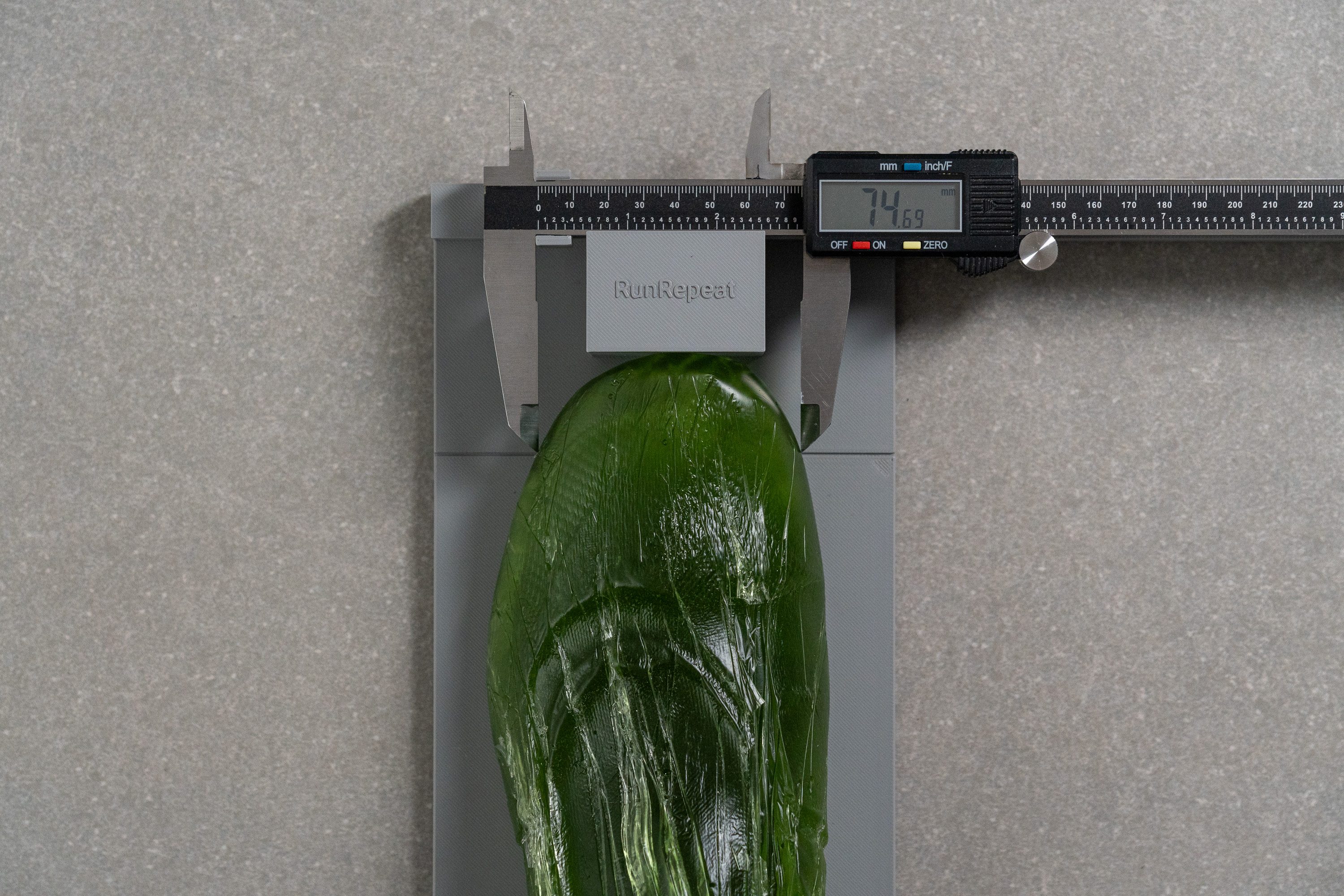
| WK400 | 74.7 mm |
| Average | 71.2 mm |
Toebox height
The shoe also provides enough vertical space in the toebox as we measured the distance between the insole and the fabric at a standard 26.1 mm.

| WK400 | 26.1 mm |
| Average | 26.4 mm |
Offset lacing
You might as well be surprised by the shoe's offset lacing design.
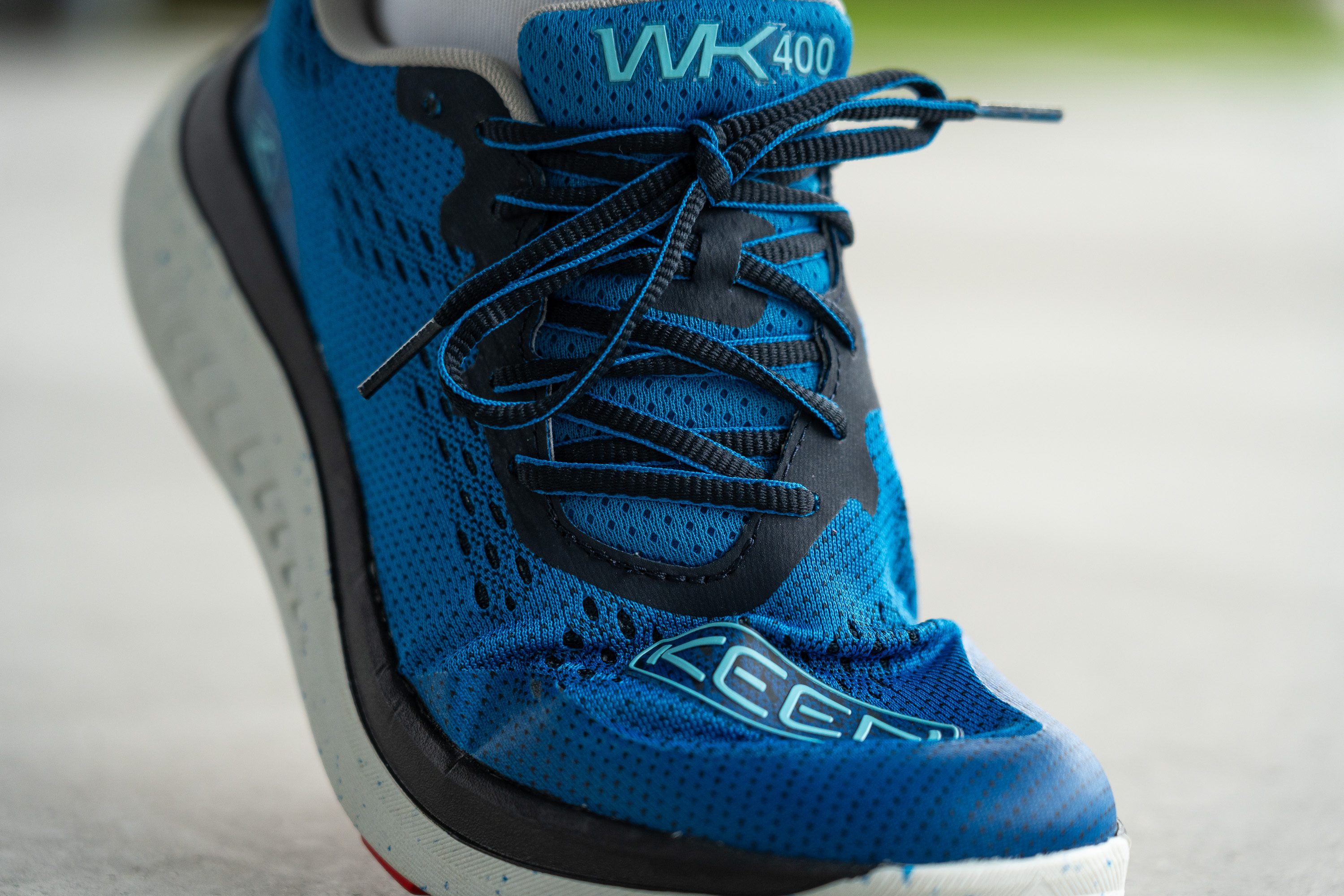
Like the rest of this KEEN shoe, it felt alien at first but we got used to it within the first hour. Although we cannot pinpoint any outstanding benefits of this setup, it didn't cause any pressure points either.
Traction / Grip
Traction test
Visually, the KEEN WK400's outsole design appears to be very grippy, especially given its razor-blade lugs in the heel. But is there enough dynamic friction to prevent the foot from slipping? Our grip test showed that it's a mixed bag.
While there is no slipping hazard on dry pavement, the KEEN WK400 does not guarantee sufficient traction on wet sidewalks and smooth surfaces.
To mimic a walking person's heel landing, our machine stomped the shoe's heel with a 500N force and at a 7-degree angle. Sadly, the shoe's friction score came in at only 0.36 which reveals the WK400's less grippy nature.
| WK400 | 0.36 |
| Average | 0.46 |
Outsole design
We found the WK400's outsole appearance to be deceiving. It looks notably more tacky and aggressive relative to the grip it provides.
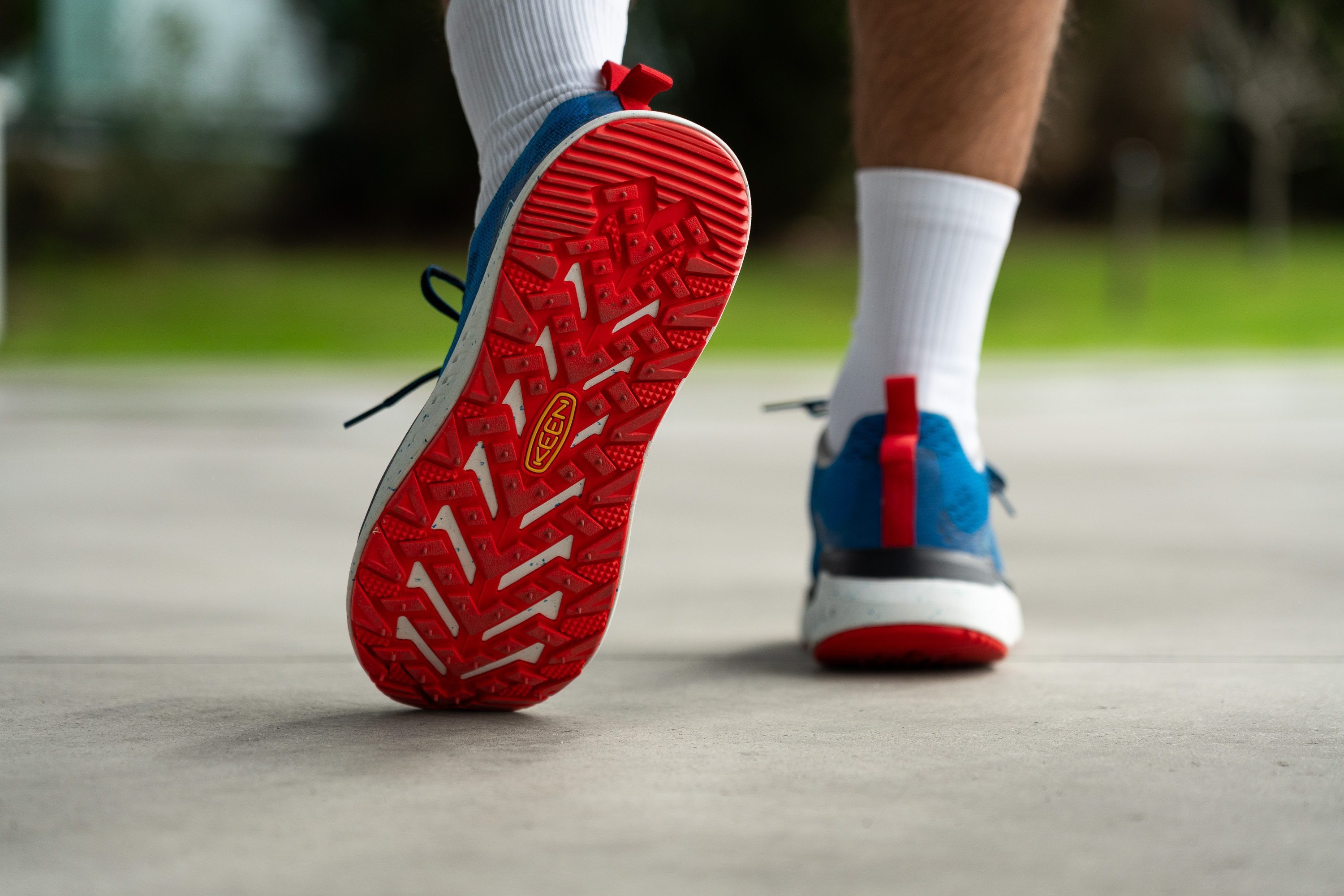
Flexibility / Stiffness
The stiff plate we mentioned earlier is an essential component of the shoe's rockered design. It helps to maintain the sole's curved shape as our feet roll from heels to toes.
To measure the level of stiffness in this KEEN shoe, we bent it to a 30-degree angle using a shoe flexing tester. The machine showed that it took as much as 23.4N of force to do that which is a whopping 70% more than it takes an average walking shoe!
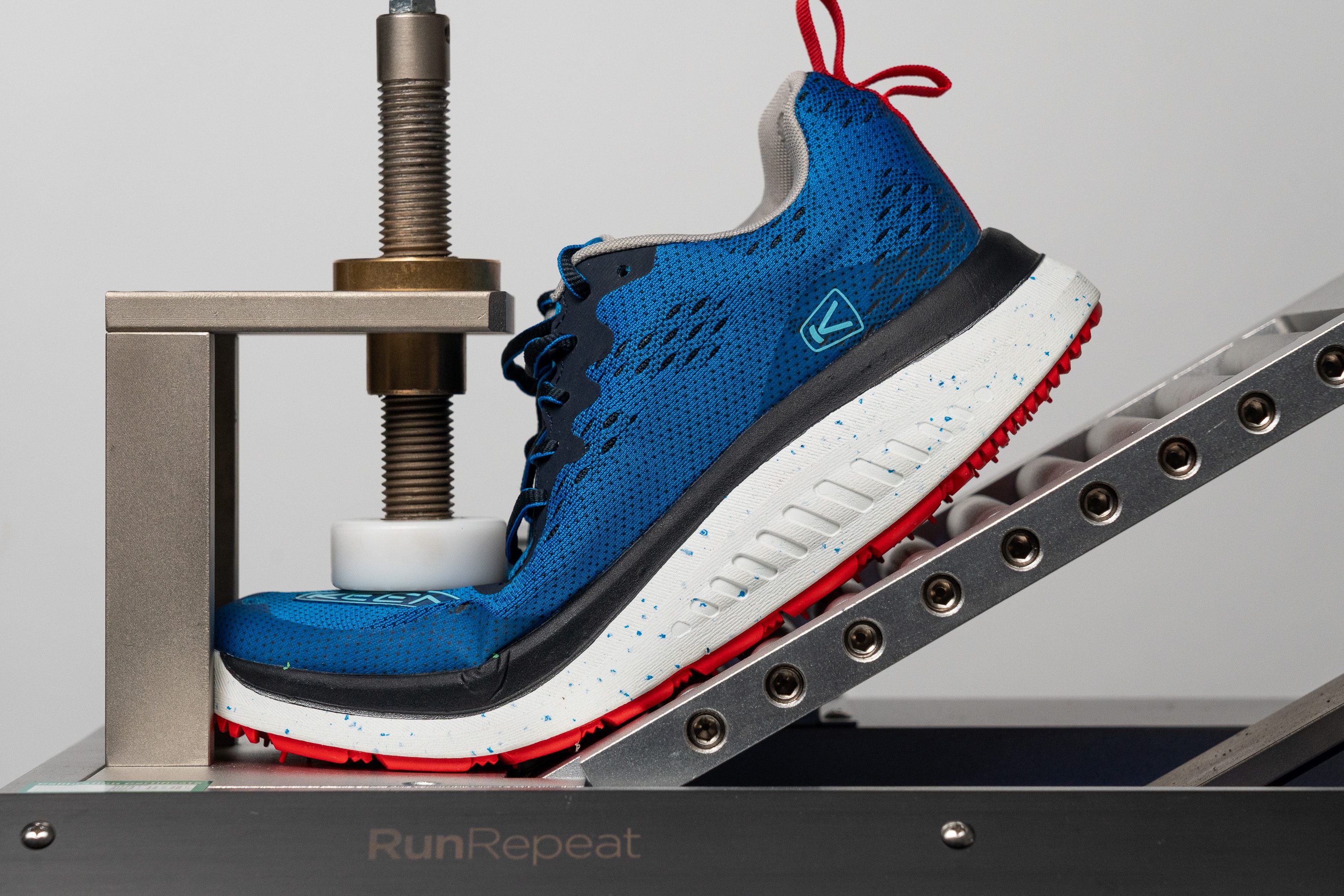
| WK400 | 23.4N |
| Average | 13.9N |
Weight
To afford its copious amount of cushioning and rubber outsole, the WK400 has to pay with weight.
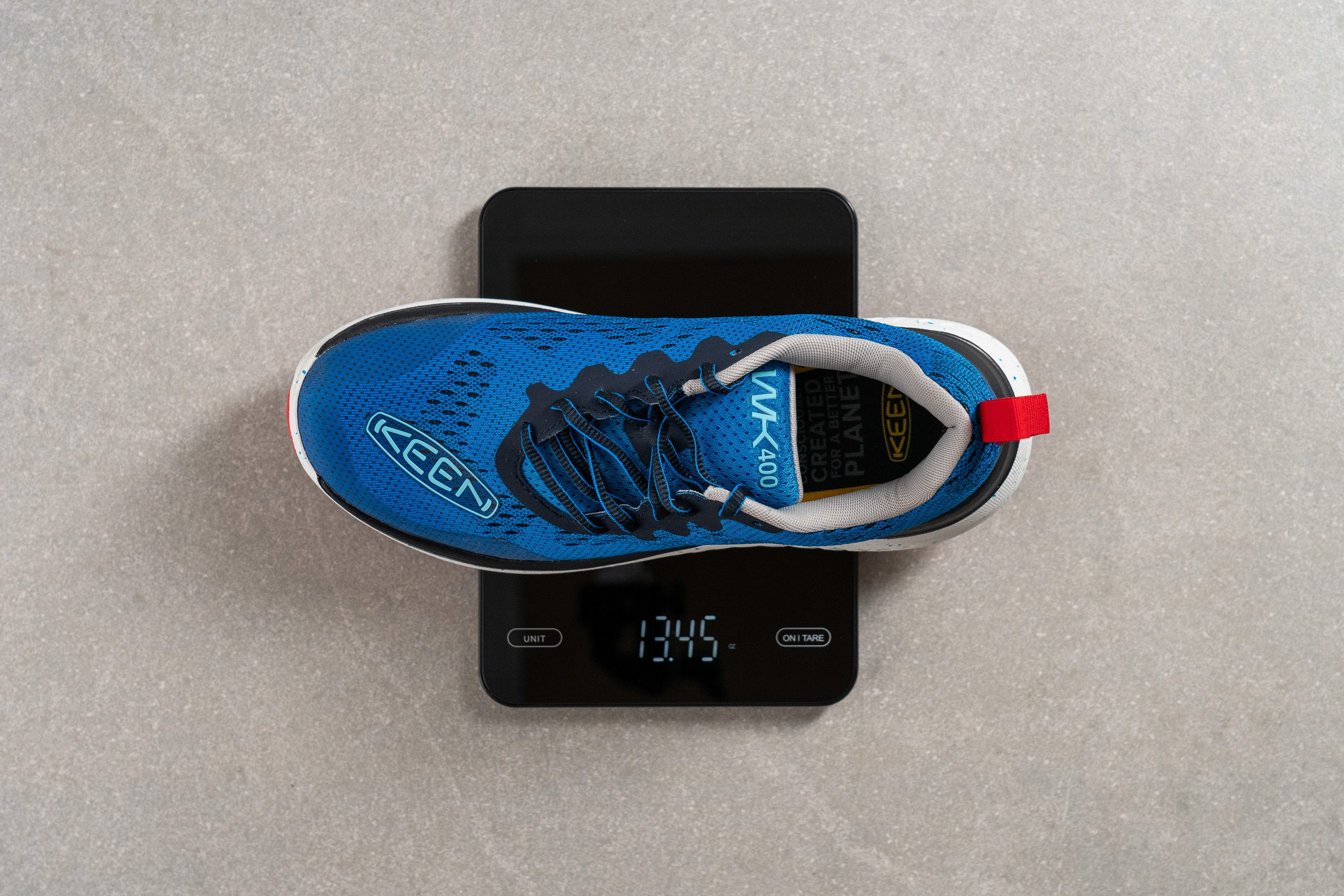
Tipping the scale at 13.4 oz (381g) in a men's US size 9, this KEEN shoe is among the heaviest walking shoes we've tested. It is not your featherweight Skechers shoe.
But we must also point out that we didn't feel the shoe's heft thanks to its rocker-bottom design. The forward-rolling sensation it created made the heft less noticeable.
| WK400 | 13.4 oz (381g) |
| Average | 10.2 oz (288g) |
Breathability
At first, the mesh upper on the KW400 looked very promising. But we quickly came to realize that all those ventilation holes on the upper don't do much for the shoe's breathability.
Just look at how little smoke is passing through this KEEN shoe's upper in our breathability test below.
Assessing its ventilation capacity on a 1-5 scale, we gave it a moderate score of 3. While it's not stuffy, we think that the WK400 feels best in moderately warm weather.
A closer look at the mesh helped us understand why the shoe lacks aeration.

That's because the shoe's upper fabric is made of two layers! It surely detracts from the shoe's performance in hot weather but in return makes it more versatile for those transition periods between summer and winter.

| WK400 | 3 |
| Average | 2.9 |
Stability
Lateral stability test
Just by looking at it, we would never think that the KEEN WK400 is a stable shoe. But to our great surprise, it is!
Sure, its lateral stability is not very reliable because of the rocker and we certainly don't recommend making forceful side-to-side steps in it. But if you stick to forward movements (as expected in walking), you will be treated to a very stable ride.
Torsional rigidity
The shoe comes with a very stiff full-length nylon plate that sits right beneath the insole. It made us feel more stable on our feet without losing the benefits of soft cushioning.
It also adds a great deal of torsional rigidity to the WK400. Twisting the shoe in our manual test, we rated its stiffness with the highest score of 5.
| WK400 | 5 |
| Average | 2.9 |
Heel counter stiffness
We also felt that the shoe held our heels and ankles firmly in place, preventing inward rolling and heel slippage.
Assessing the shoe's heel counter stiffness on a 1-5 scale, we felt a lot of resistance and rated it with a high score of 4. You can expect a great deal of support not only from the shoe's midsole but also from its upper.
| WK400 | 4 |
| Average | 2.4 |
Midsole width - forefoot
To make the WK400 as stable as it can be, KEEN granted it one of the widest platforms we've seen in walking shoes.
Measuring the widest part of the shoe's midsole in the forefoot, our caliper showed 115.5 mm. That's a few millimeters wider than average.
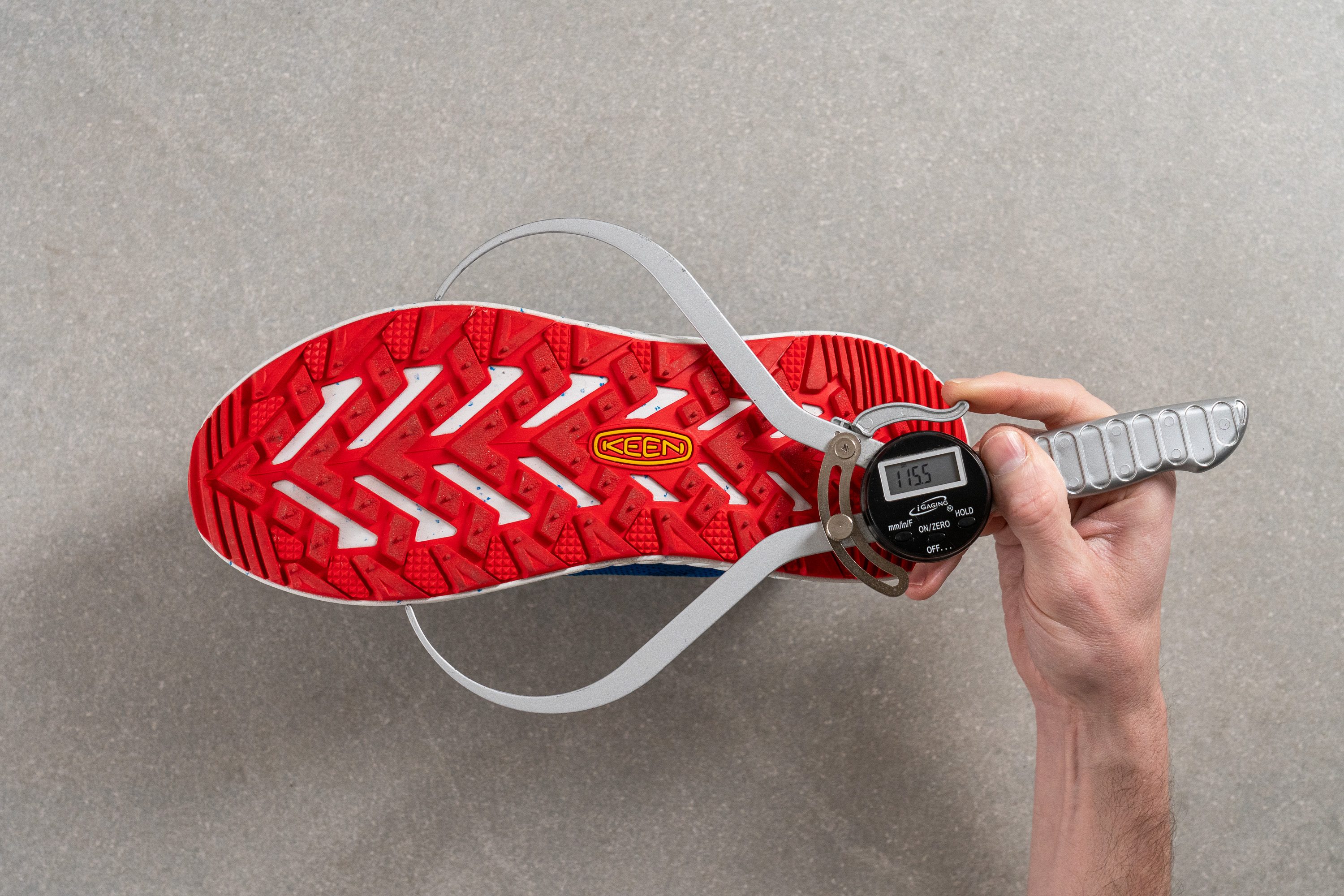
| WK400 | 115.5 mm |
| Average | 112.0 mm |
Midsole width - heel
If the shoe's rockered sole still makes you feel unsure about stability, take a look at the width of its heel!
With 97.0 mm in the widest part, it is among the widest platforms you can find in walking shoes.

| WK400 | 97.0 mm |
| Average | 90.3 mm |
Durability
Toebox durability
KEEN is a long-standing outdoor brand that sure knows how to make durable footwear.
Thus, we were not surprised to see a barely visible yet highly protective translucent layer on the WK400. Covering the shoe's toebox, it guards the fabric from bumps and tears.
Equipped with a Dremel, we went full force drilling this sensitive part of the shoe. Maintaining consistent speed (5K RPM) and pressure (3.2N), we held the tool's sandpaper tip for 12 seconds.

And we must say, without that overlay, the KEEN WK400 would've ended up with the same glaring hole as the shoe on the right. But luckily, it earned an average score of 3 for toebox durability.
| WK400 | 3 |
| Average | 3.2 |
Heel padding durability
But to our disappointment, the shoe's inner lining didn't perform as well for a $160 shoe.
It took our Dremel as little as 4 seconds to blow through the mesh fabric on the shoe's heel padding. Even a $100 cheaper Skechers shoe (on the right) stood up to the test!
Rating the shoe's heel padding durability from 1 to 5, we couldn't give it higher than 2.
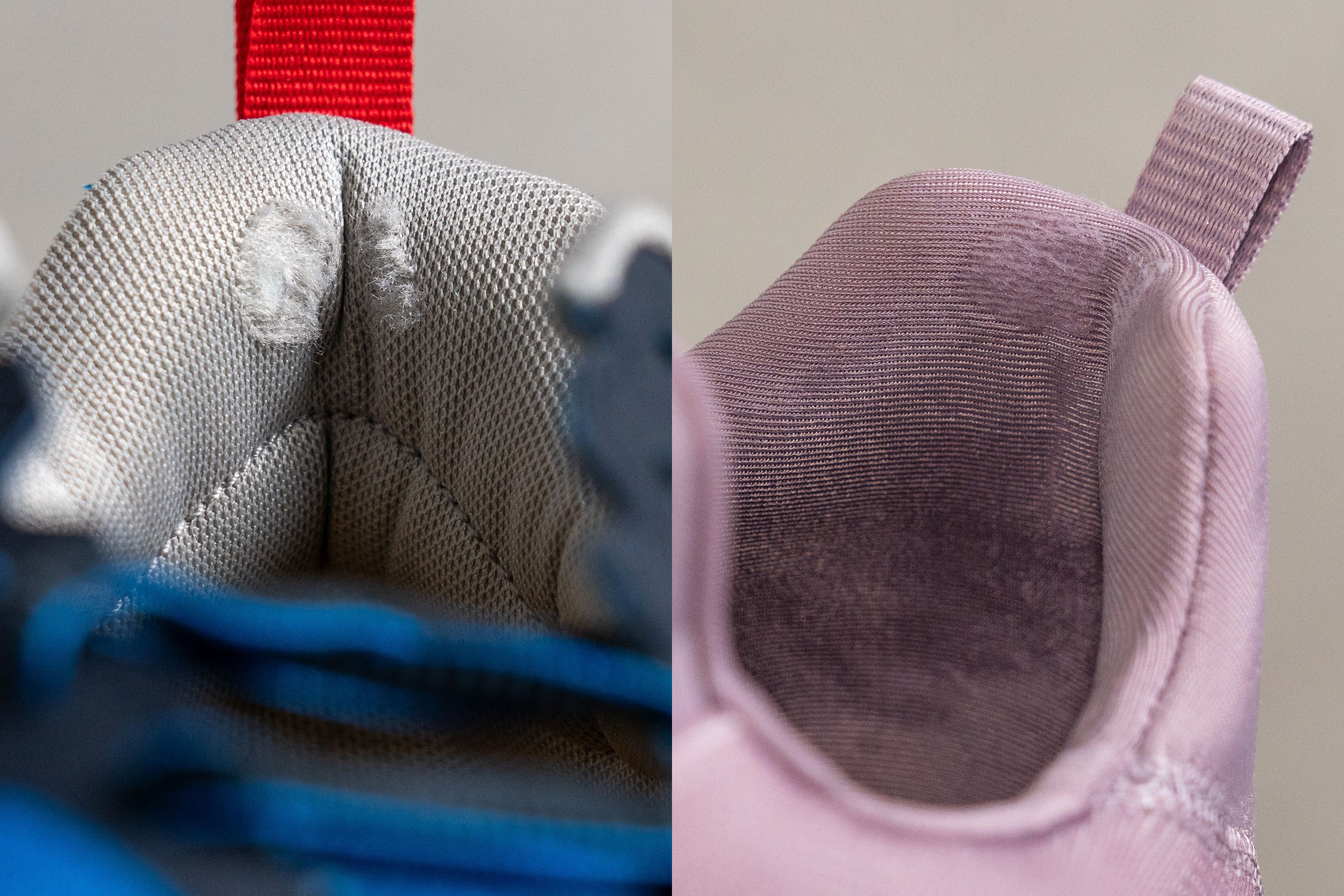
But the good news is that it is one of the few areas that could be improved in the KEEN WK400.
| WK400 | 2 |
| Average | 2.3 |
Outsole hardness
KEEN must've used its best practices from hiking shoes to make the WK400's outsole.
When we pressed our durometer against the rubber, the tool returned a high reading of 85.4 HC. This is 13% harder than the average of walking shoes and is a good indicator of durability.

| WK400 | 85.4 HC |
| Average | 78.0 HC |
Outsole durability
We've got to say, the outsole of the WK400 exceeded our expectations in the Dremel test!
Even though we had set the tool's speed to the relentless 10K RPM and held its sandpaper tip for a very long 22 seconds, the rubber refused to give in!
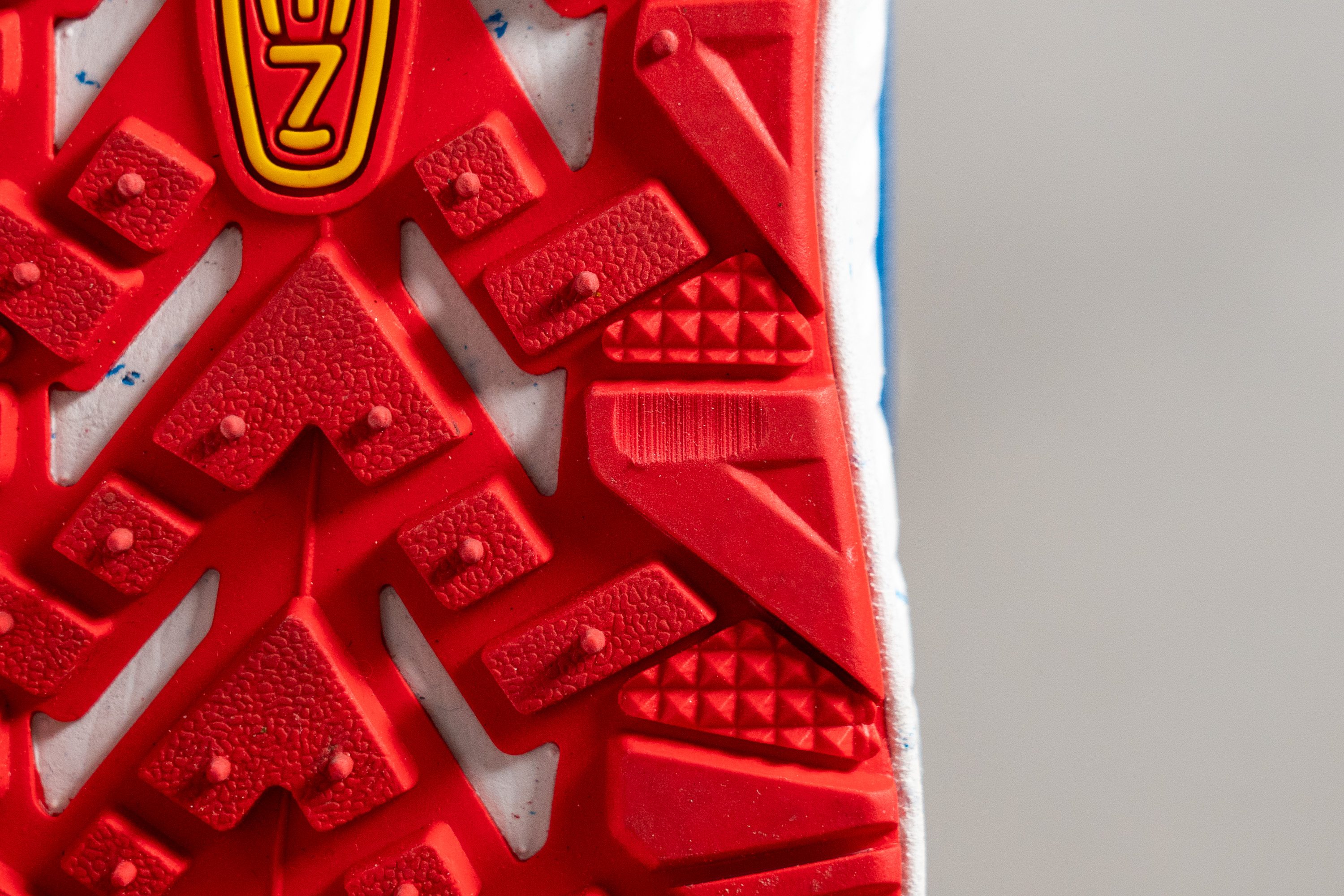
According to our tread gauge measurement, the dent ended up as shallow as 0.3 mm. It is nothing more than a scuff!
| WK400 | 0.3 mm |
| Average | 1.4 mm |
Outsole thickness
Like that wasn't enough, KEEN also used a very thick layer of rubber for the outsole.
Measuring it with a caliper, we got a whopping 5.0 mm. That's 50% thicker than the average walking shoe!
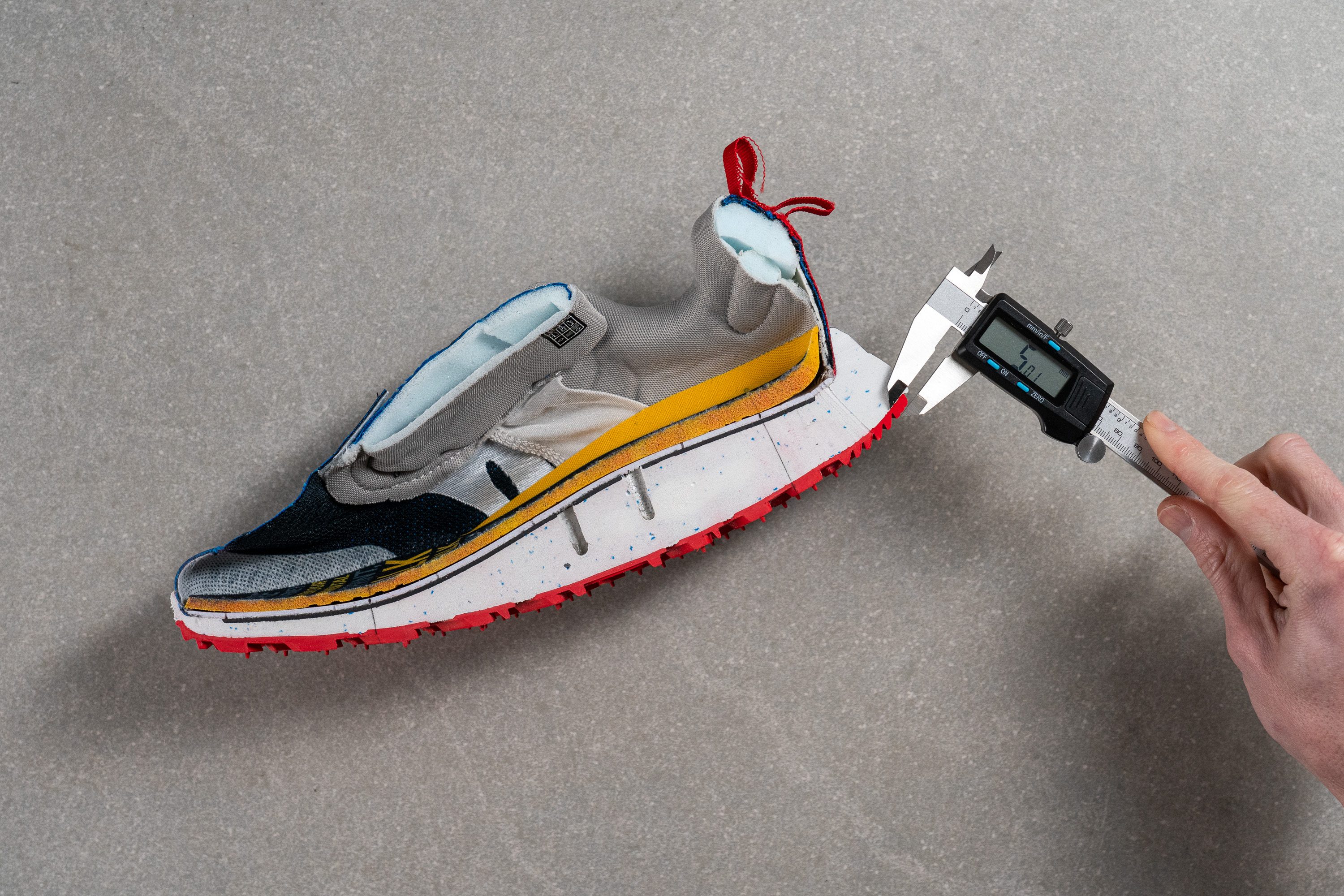
All things considered, we can guarantee that the KEEN WK400 is going to have a longer and happier life than many shoes out there. Even if you take it beyond roads and manicured paths.

| WK400 | 5.0 mm |
| Average | 3.0 mm |
Misc
Insole thickness
The comfort is further amplified by a generously padded insole. Measuring its thickness with a caliper, we got an impressive 7.5 mm which is thicker than average.

| WK400 | 7.5 mm |
| Average | 5.8 mm |
Removable insole
There is an option to replace the shoe's stock insole with your own. But we don't think it would be necessary given its extra plush padding and contoured shape.
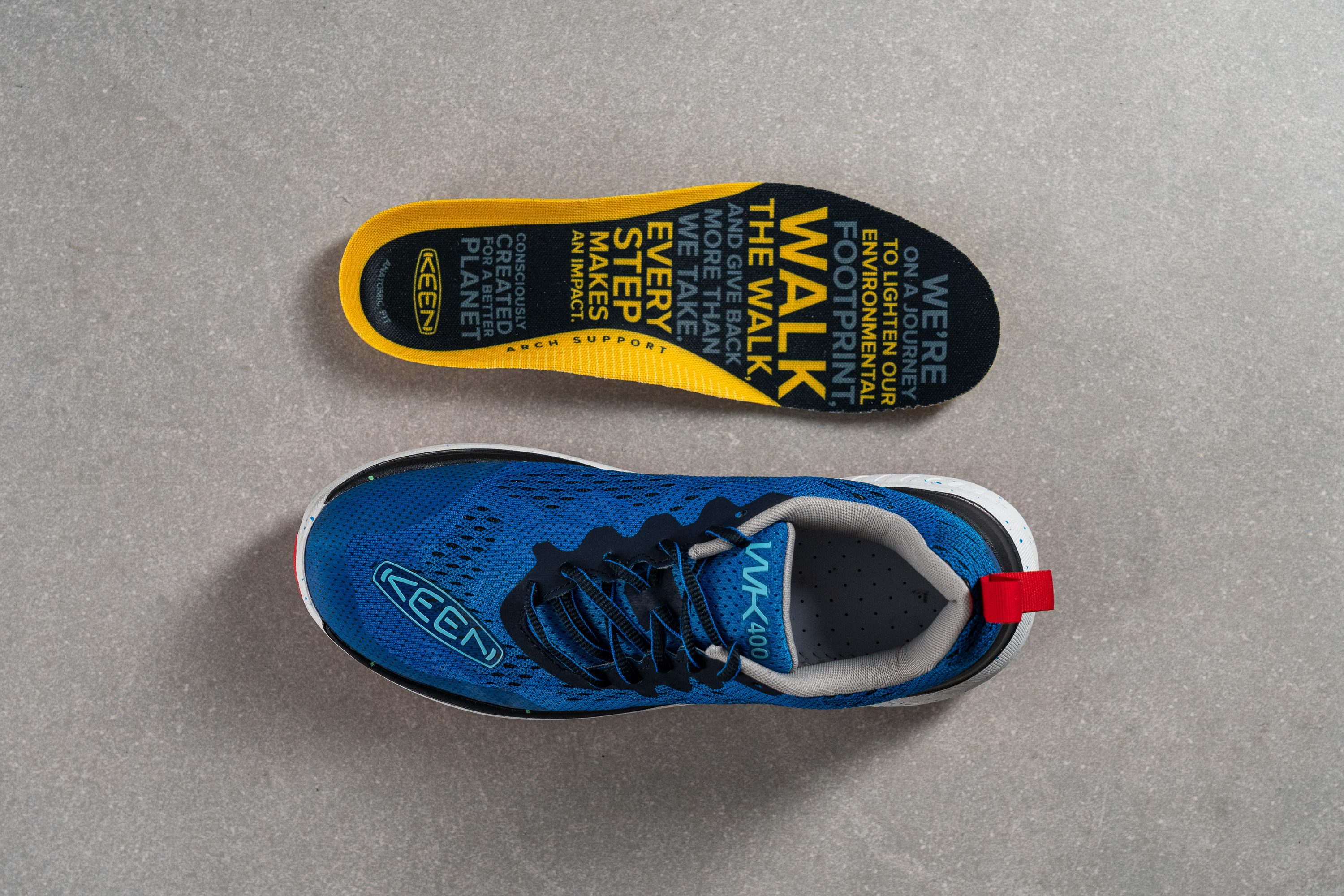
| WK400 | Yes |
Midsole softness in cold (%)
Another magical aspect of this foam is that it doesn't seem to be subject to cold. If you choose to wear the shoe on a colder day, the plushness will still be there!
After keeping the WK400 in the freezer for 20 minutes, we repeated the durometer measurement and found that the foam only got 6.8% firmer!
This is impressive considering that on average walking shoe foams get 33.2% harder.
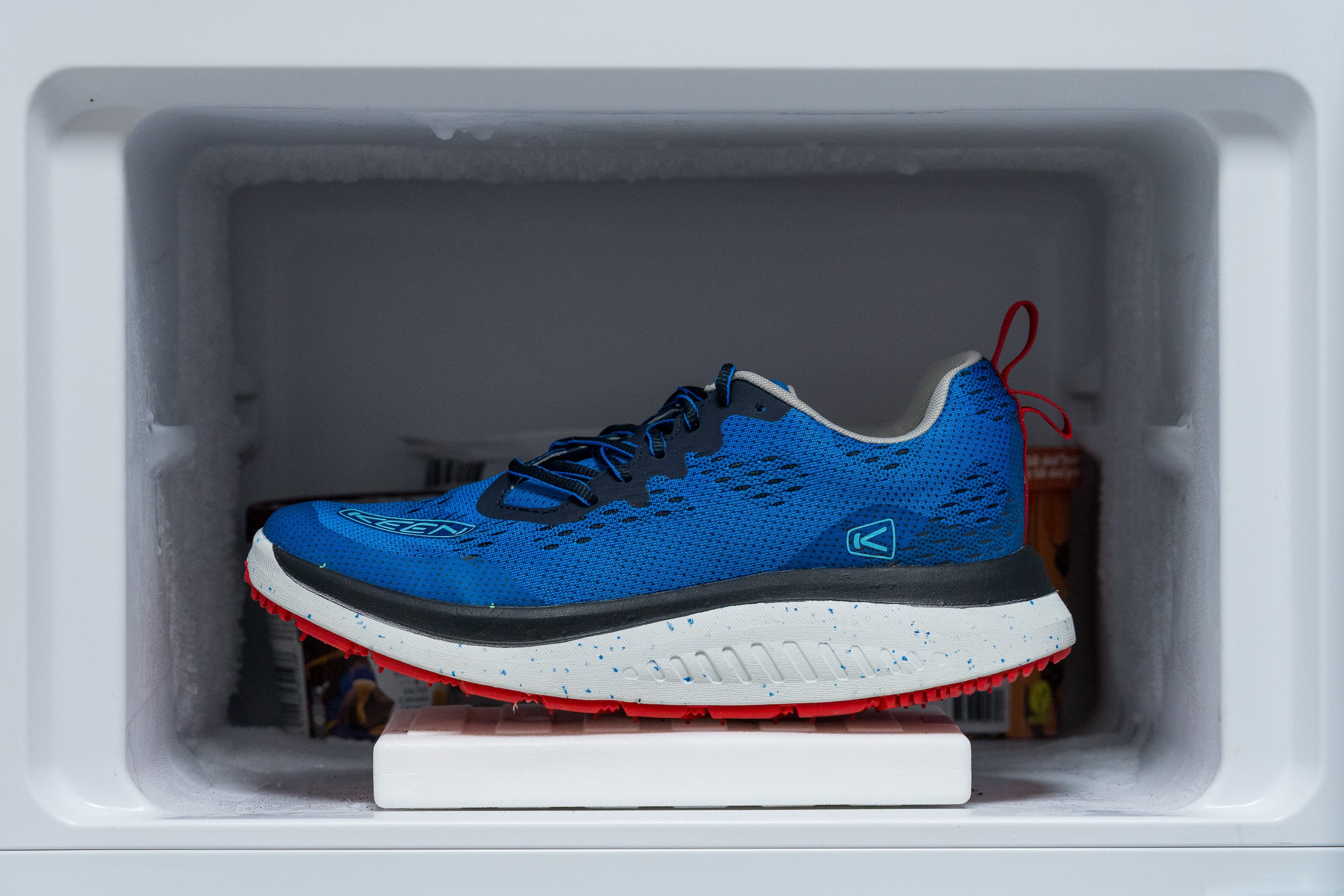
| WK400 | 7% |
| Average | 30% |
Reflective elements
Better be home before dark! This KEEN shoe doesn't have any reflective elements to make you visible in low-light conditions.
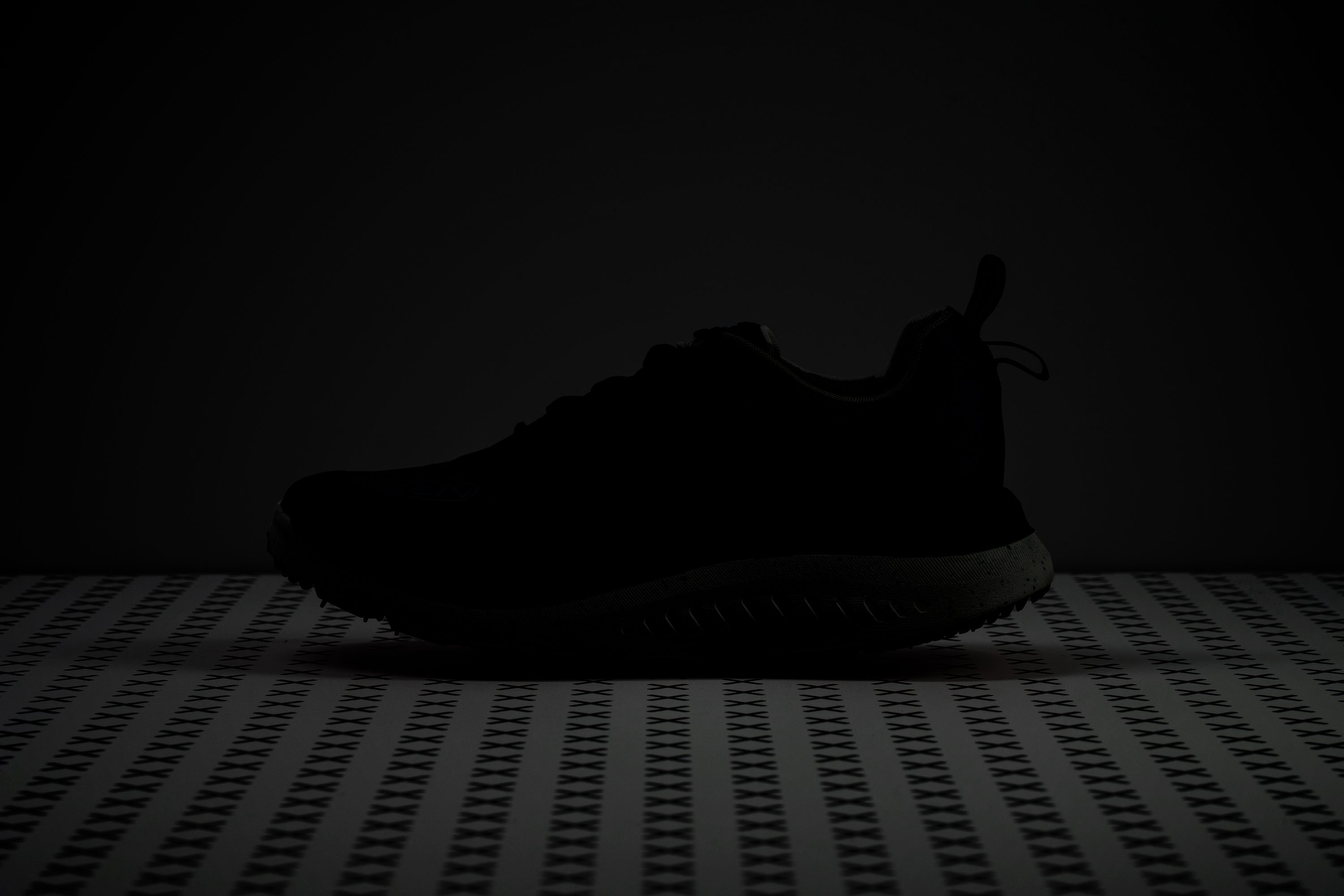
| WK400 | No |
Tongue padding
The interiors of the WK400 are lavishly padded in both the tongue and the collar.
Measuring the tongue thickness with a caliper, we got 9.0 mm which is a few good millimeters thicker than average.
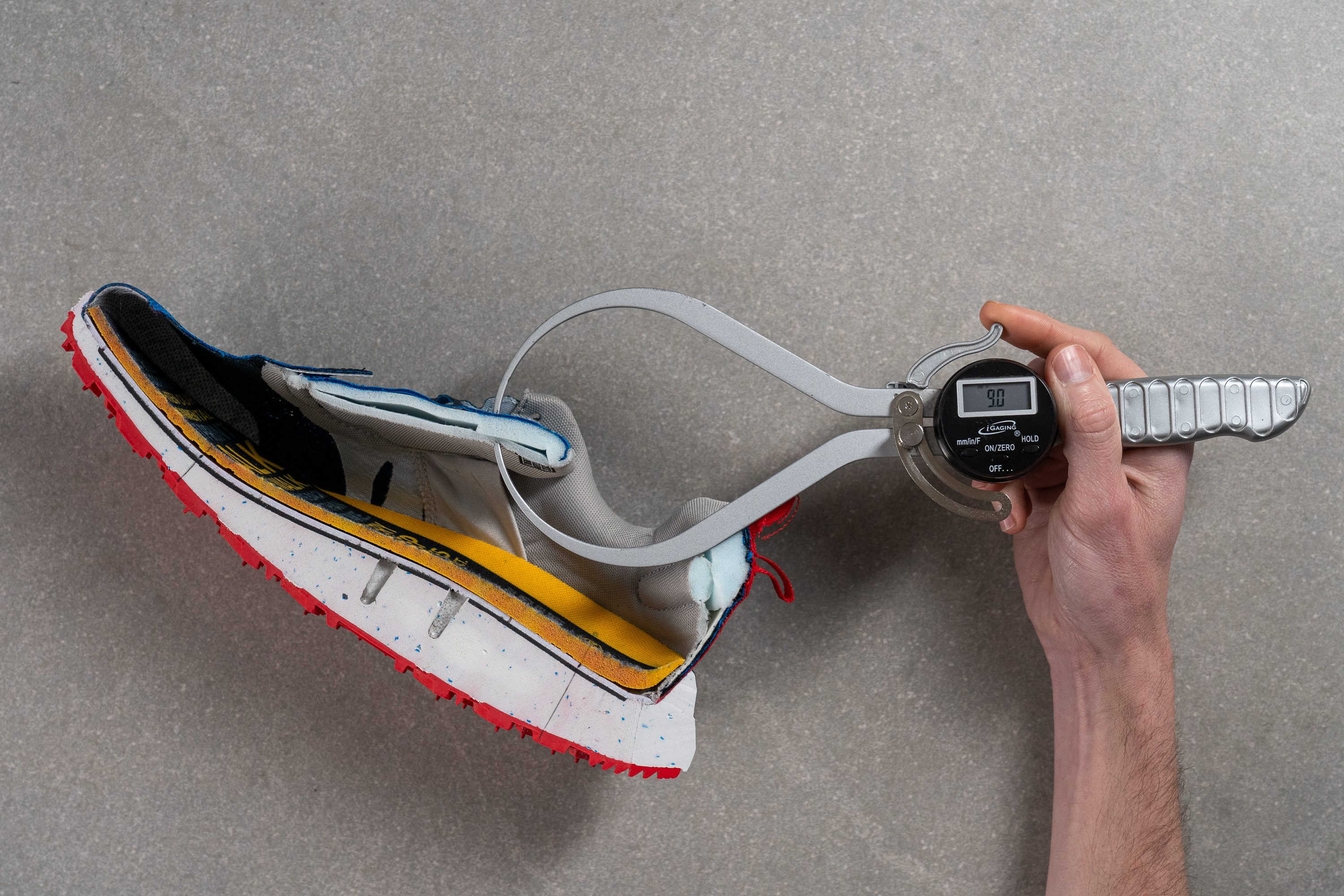
Combined with the shoe's thick insole and cushy midsole, this KEEN shoe provides an exceptionally cozy step-in feel.
| WK400 | 9.0 mm |
| Average | 5.6 mm |
Tongue: gusset type
The tongue of the WK400 is partially attached to the upper on both sides.
This creates a more secure midfoot hold while also preventing the tongue from bunching and sliding.
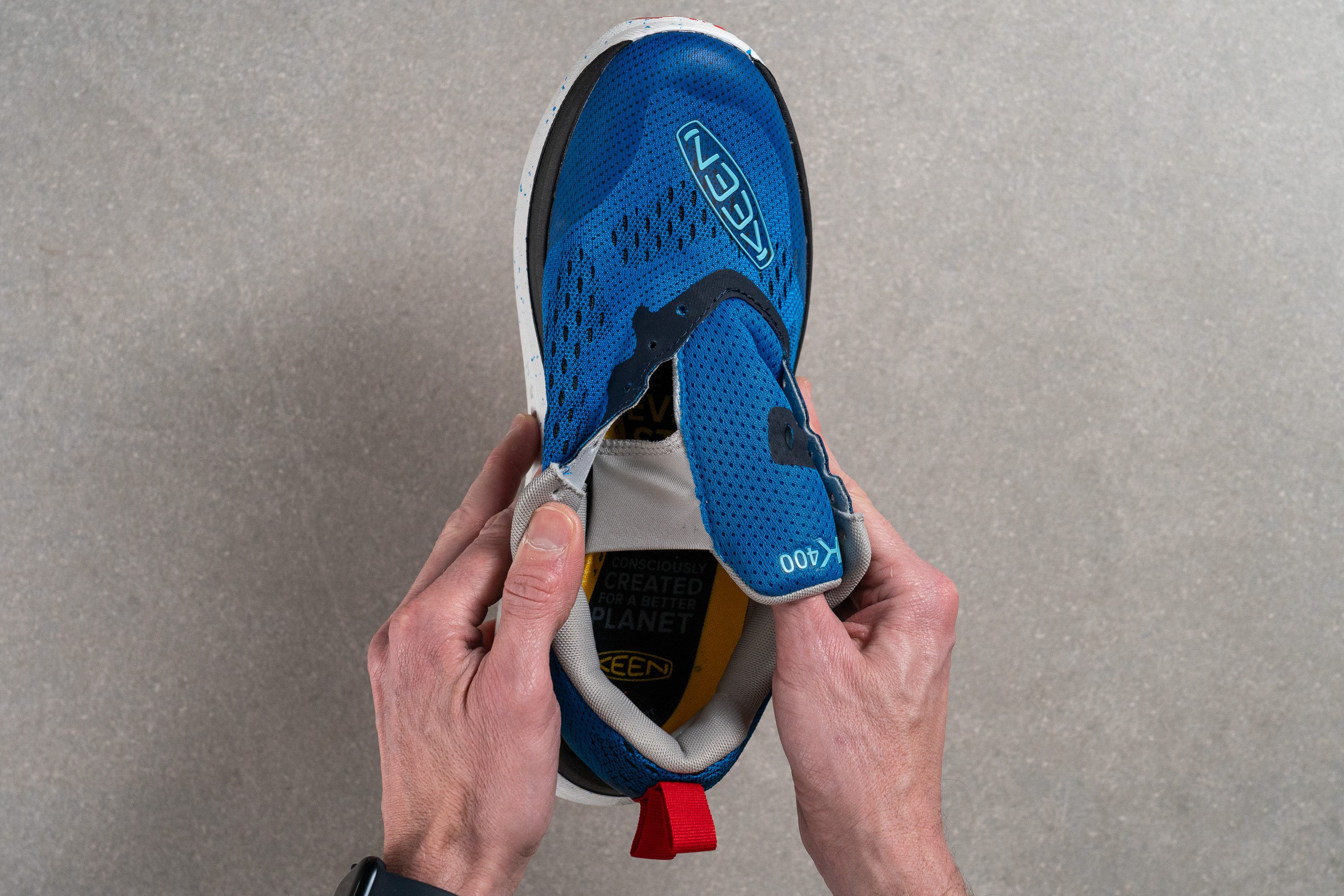
| WK400 | Both sides (semi) |
Heel tab
A small but thoughtful detail is the shoe's two-finger webbing loop. It is an unusual design that comes super handy when getting the shoe on.

| WK400 | Finger loop |























































